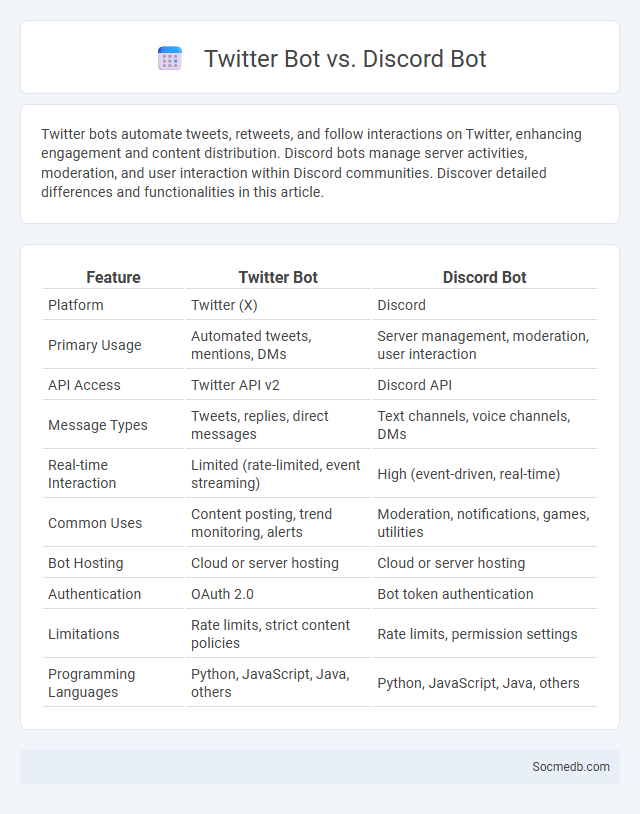
Photo illustration: Twitter Bot vs Discord Bot
Twitter bots automate tweets, retweets, and follow interactions on Twitter, enhancing engagement and content distribution. Discord bots manage server activities, moderation, and user interaction within Discord communities. Discover detailed differences and functionalities in this article.
Table of Comparison
| Feature | Twitter Bot | Discord Bot |
|---|---|---|
| Platform | Twitter (X) | Discord |
| Primary Usage | Automated tweets, mentions, DMs | Server management, moderation, user interaction |
| API Access | Twitter API v2 | Discord API |
| Message Types | Tweets, replies, direct messages | Text channels, voice channels, DMs |
| Real-time Interaction | Limited (rate-limited, event streaming) | High (event-driven, real-time) |
| Common Uses | Content posting, trend monitoring, alerts | Moderation, notifications, games, utilities |
| Bot Hosting | Cloud or server hosting | Cloud or server hosting |
| Authentication | OAuth 2.0 | Bot token authentication |
| Limitations | Rate limits, strict content policies | Rate limits, permission settings |
| Programming Languages | Python, JavaScript, Java, others | Python, JavaScript, Java, others |
Introduction to Bots: Twitter, Discord, and General Bots
Bots on social media platforms like Twitter and Discord automate interactions, content posting, and user engagement, enhancing communication efficiency. Twitter bots manage tweet scheduling, trend tracking, and follower interactions, while Discord bots facilitate server moderation, user management, and real-time notifications. General bots utilize APIs to perform tasks such as data collection, sentiment analysis, and personalized responses, streamlining social media management across multiple platforms.
Core Differences Between Twitter Bots and Discord Bots
Twitter bots primarily automate content posting, retweeting, and following activities to boost engagement and presence on the platform, while Discord bots focus on managing server interactions, moderating chats, and facilitating user roles within communities. The core distinction lies in their operational environments; Twitter bots interact with a public social media feed, leveraging the Twitter API for real-time content dissemination, whereas Discord bots are embedded in private or semi-private chat servers, utilizing Discord's API to enhance communication and user experience. Understanding the specific functionalities and API capabilities of each bot type is crucial for effective deployment in social media strategies, ensuring tailored automation and community management.
Key Features of Twitter Bots
Twitter bots automate interactions by using AI algorithms to post tweets, retweet, like, and follow users based on programmed criteria. They leverage natural language processing (NLP) to generate relevant content and engage with trending hashtags, enhancing user engagement and brand visibility. Advanced Twitter bots also analyze real-time social media data to target specific audiences and optimize posting schedules for maximum reach.
Key Features of Discord Bots
Discord bots offer key features such as automated moderation to maintain community guidelines and prevent spam, customizable commands to enhance user interaction, and integration capabilities with external platforms like YouTube or Twitch for streamlined content sharing. These bots also provide real-time notifications, music playback functionalities, and analytics to monitor server activity and engagement metrics. The scalability and ease of customization make Discord bots essential tools for managing vibrant and interactive social media communities.
General Purpose Bots: An Overview
General purpose bots operate across multiple social media platforms to automate tasks such as content sharing, user interaction, and data analysis. These bots leverage natural language processing and machine learning algorithms to engage with diverse audiences, enhancing brand presence and customer support. Their flexibility allows adaptation to various marketing strategies, making them essential tools for businesses aiming to optimize social media performance.
Use Cases: Twitter Bot vs Discord Bot vs General Bots
Twitter bots excel in real-time engagement by automating tweets, retweets, and direct messaging for brand promotion and customer interaction. Discord bots enhance community management with features like moderation, event scheduling, and interactive games tailored for server members. General bots provide versatile automation across platforms, handling tasks such as data collection, user support, and content distribution to improve efficiency and user experience.
Development and Programming: Platforms and Tools
Social media development leverages advanced programming languages like JavaScript, Python, and PHP to create scalable platforms such as Facebook, Instagram, and Twitter. Developers utilize frameworks and tools like React, Node.js, and Django for building responsive user interfaces and robust backend systems. APIs and SDKs enable seamless integration of third-party services, enhancing platform functionality and user engagement.
Security and Moderation Considerations
Social media platforms require robust security measures to prevent unauthorized access, data breaches, and identity theft, safeguarding user information through encryption and multi-factor authentication. Effective moderation techniques, including AI-powered content filtering and human review, are essential to manage harmful content such as hate speech, misinformation, and cyberbullying. Maintaining a balance between user privacy and transparent content policies ensures a safer and more trusted online community.
User Engagement: How Bots Interact on Each Platform
Bots on social media platforms like Twitter, Facebook, and Instagram significantly influence user engagement by automating likes, comments, and shares that can inflate interaction metrics. Twitter bots often amplify trending topics through retweets and replies, while Facebook bots engage users via automated messaging and comment responses within groups and pages. Instagram bots primarily increase visibility through mass following, liking, and commenting, subtly shaping user behavior and content reach on the platform.
Choosing the Right Bot for Your Needs
Selecting the right social media bot involves analyzing your specific goals such as increasing engagement, automating responses, or content curation. Evaluate key features like AI capabilities, compatibility with platforms like Instagram or Twitter, and compliance with platform policies to avoid account suspension. Prioritize bots that offer customizable workflows, analytics, and user-friendly interfaces to maximize efficiency and ROI.
 socmedb.com
socmedb.com